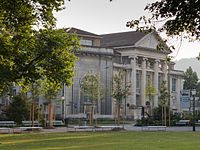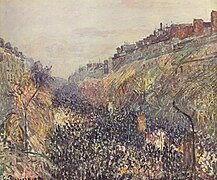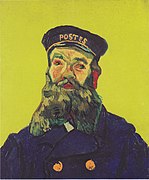Kunst Museum Winterthur - by the town hall
| Art Museum Winterthur At the town hall |
|
|---|---|

|
|
| Data | |
| place | Museumstrasse 52 8400 Winterthur Switzerland |
| Art | Art museum |
| architect |
Rittmeyer & Furrer , Gigon & Guyer (extension) |
| opening | January 2, 1916 |
| Number of visitors (annually) | 19,680 (2016) |
| operator | Kunstverein Winterthur |
| management | Konrad Bitterli |
| GLAM | CH-001485 |
| Website | www.kmw.ch |
The Art Museum Winterthur | At the Stadthaus , which was Kunstmuseum Winterthur until December 2017 , is an art museum that was opened in 1916 and is located in the old town of Winterthur .
It houses an important Swiss collection of art from the late 19th century to the present and is therefore the house of modernity among the Winterthur art collections . The owner is the Kunstverein Winterthur , founded in 1848 , which is supported by the city of Winterthur and the canton of Zurich as well as the association members and patrons .
Konrad Bitterli has been the director of the museum since 2017 . In 2018 the art museum was merged with the Museum Oskar Reinhart and the Villa Flora to form the Kunst Museum Winterthur .
history
The museum is sponsored by the Kunstverein Winterthur , which was founded in 1848 and which owns the museum's collection. The association is subsidized by the city of Winterthur and the canton of Zurich, but is also based largely on private contributions. Initially, the association members were encouraged to have watercolors and drawings ready for the association. A national collection did not begin until the death of the Winterthur painter Johann Caspar Weidenmann in 1850 , whose estate was acquired by the city of Winterthur at the instigation of the local artist society. The Kunstverein began its subsequent acquisitions with the work Narcissus, reflected in the water . The acquisitions included paintings by Swiss artists a. a. Anton Graffs . In 1899 the association achieved national recognition with the purchase of Ferdinand Hodler's Der Lebensmüde . Since the collection had to get by without its own museum building and was housed in the art gallery on Marktgasse , a board of directors acquired a new building in 1907/08.
The donations made by Richard Bühler , textile manufacturer, Arthur Hahnloser , ophthalmologist, and Georg Reinhart , entrepreneur, were particularly significant. In 1913 the gallery association was founded in order to be able to make further purchases. Today the gallery association bears the nickname "Friends of the Art Museum Winterthur". In 2013 it celebrated its 100th anniversary with the creation of an outdoor sculpture by the Welsh artist Richard Deacon .
From the 1930s onwards, the museum's long-time curator, Heinz Keller , was criticized by the Kunstverein, which initially took a stand against abstract art , because of his purchasing policy. The new president of the association, Balthasar Reinhart , businessman, made it possible in 1960 to acquire modern art through the Volkart Foundation . Provided with loans, the art association later acquired contemporary art itself . Through Reinhart's commitment in connection with the Alberto Giacometti Foundation , founded in 1965 , the Kunstmuseum Winterthur became a permanent exhibition space for works by Alberto Giacometti alongside the Kunsthaus Zürich and the Kunstmuseum Basel . With the 1973 legacy of the private banker Emil Friedrich and his wife Maria Clara Friedrich , a painter, the art museum now housed one of the most important collections of classical modernism in Switzerland. In 1999, further works by the Jezler family were included in the museum. The collection represented a contrast to the previous focus on French painting.
In 1973 the industrialist Herbert Wolfer-de Armas donated the museum's important collection of French painting, which had been enriched in particular by his father, Heinrich Wolfer , from the 1930s to the 1960s. After his death in 2004, she was physically admitted to the museum. As early as 2000, the heirs of the second son, Ulrich Wolfer, bequeathed the other part of the collection to the museum. The museum also relied on the Italian Arte Povera , with the Kunstverein Winterthur anniversary foundation making major purchases from 1995 onwards. In 2002 the legacy of Erna and Curt Burgauer was partly transferred to the museum.
Dieter Schwarz was director of the art museum for 27 years. In 2017 Konrad Bitterli became his successor.
In 2018 the Kunstmuseum Winterthur was merged with the Museum Oskar Reinhart am Stadtgarten and the Villa Flora to form the Kunst Museum Winterthur . Since then it has been called «Kunst Museum Winterthur | At the town house ».
The building
The Kunst Museum Winterthur resides on the edge of the old town , in the center of the city of Winterthur (Museumsstrasse 52) and thus in a representative setting - opposite is the town house .
It was built from 1913 to 1915 according to plans by the architects Robert Rittmeyer and Walter Furrer with the help of private donations. A first draft came from 1909. Architecturally, elements of Art Nouveau and Neoclassicism were incorporated . The opening took place on January 2, 1916.
The words “Der Kunst und Wissenschaft” can be read on the outside of the building. In addition to the art museum and the premises of the art association, the museum building initially housed the city library and the city archive, the private gallery Dr. Reinhart , the coin and engraving cabinet as well as the archaeological and scientific collection. After several extracts, starting with the Münzkabinett in 1982, only the Naturmuseum Winterthur remained in the building, apart from the art museum and the associated sponsoring association .
In 1983 the city of Winterthur announced an ideas competition with the aim of expanding the museum. However, the project was rejected in the course of a ballot in 1992. A competition from 1993 led to an expansion by the Zurich architects Gigon / Guyer , which was to be financed through private donations. This is a glazed steel structure with a shed roof , reminiscent of industrial architecture . The exhibition area had almost doubled after completion. The newer parts of the collection can be shown in the extension building, as can the temporary exhibitions . In 1997 the extension was a finalist in the Mies van der Rohe Award for European Architecture .
With the move out of the city library in 2010 and the renovation of the building carried out by Silvio Schmed and Arthur Rüegg , there are now rooms in the basement for museum education as well as a museum shop and a museum café.
The study library (“study room with reference library ”) has been housed in the city library since 2016.
The collection
The presentation of the collection opens with paintings by Claude Monet , Alfred Sisley , Vincent van Gogh , Odilon Redon , Pierre Bonnard , Edouard Vuillard , Félix Vallotton and sculptures by Auguste Rodin , Medardo Rosso and Aristide Maillol . The prominent representation of classical modernism goes back to Clara and Emil Friedrich-Jezler, who built up one of the early Swiss avant-garde collections, with works of Cubism ( Georges Braque , Juan Gris , Fernand Léger , Pablo Picasso ), abstraction and constructive art ( Robert Delaunay , Paul Klee , Hans Arp , Piet Mondrian ). The great modern sculptors - Constantin Brâncuși , Alexander Calder , Henri Laurens , Wilhelm Lehmbruck - also have their place here. The post-war collection shines with Alberto Giacometti and Giorgio Morandi . International contemporary art has particular weight with groups of works from American art - Ellsworth Kelly , Philip Guston , John Chamberlain , Eva Hesse , Agnes Martin , Robert Ryman , Robert Mangold , Brice Marden , Richard Tuttle - and Italian art from Lucio Fontana and Piero Manzoni to about Arte Povera - Luciano Fabro , Jannis Kounellis , Mario Merz , Giulio Paolini , Giuseppe Penone . Starting with Gerhard Richter and Richard Hamilton , the collection opens up to new tendencies with works by Isa Genzken , Thomas Schütte , Thomas Scheibitz , Pedro Cabrita Reis , Rita McBride . Parts of the collection from the time before 1900 are on display in the Oskar Reinhart Museum.
Every year in December there is an exhibition by the Winterthur artist group in the museum.
Exhibited works
Exhibitions
- 2013: moments. Henri Michaux .
- 2015/16: From Eugène Delacroix to Giovanni Giacometti . French and Swiss drawings from the collection
- 2016: Hans Arp | William Tucker | Richard Tuttle καλλίρροος beautiful-flowing | Matt Mullican - Nothing Should Exist | 100 years December exhibition
- 2016/2017: Ker-Xavier Roussel - L'après midi d'un faune
- 2017: Joel Shapiro : Early and New Sculptures | Antonio Calderara (1903–1978)
- 2017: Jean Fautrier
- 2018: Ferdinand Hodler - Alberto Giacometti . An encounter.
literature
- Dieter Schwarz: Kunstmuseum Winterthur. Swiss Institute for Art Research / Foundation BNP Paribas Switzerland, Zurich and Geneva 2007 (= Museums of Switzerland).
- Kunstmuseum Winterthur: Catalog of paintings and sculptures. Volumes 1-3. Published by Dieter Schwarz, Richter Verlag, Düsseldorf 2005–2011.
- From Edgar Degas to Gerhard Richter: Works on paper from the collection of the Kunstmuseum Winterthur. Published by Dieter Schwarz, Richter Verlag, Düsseldorf 2000.
- 100 years gallery association, friends of the Kunstmuseum Winterthur 1913–2013. Gallery Association, Friends of the Kunstmuseum Winterthur, Winterthur 2013.
- Department of Culture and Services of the City of Winterthur, Silvio Schmed and Arthur Rüegg (eds.): Museum and library building Winterthur. Renewal and expansion. gta Verlag, Zurich ISBN 978-3-85676-288-9 .
Web links
- Kunstmuseum im Winterthur Glossary.
- Official website of the Kunstmuseum Winterthur
- Gallery Association - Friends of the Kunstmuseum Winterthur
- Kunstmuseum Winterthur at museums.ch
- Portrait of the Kunstmuseum Winterthur on ART-TV
Individual evidence
- ^ Kunstmuseum Winterthur (ed.), Annual Report 2016, Winterthur 2017, p. 3.
- ^ Dieter Schwarz: Kunstmuseum Winterthur. Geneva 2007, p. 6.
- ^ Dieter Schwarz: Kunstmuseum Winterthur. Geneva 2007, p. 7.
- ^ Dieter Schwarz: Kunstmuseum Winterthur. Geneva 2007, p. 9.
- ^ Schwarz Dieter, * 1953, director of the Kunstmuseum 1990–2017 in the Winterthur Glossary.
- ↑ Luzi Dosch: Rittmeyer & Furrer: a community of architects between Art Nouveau and new building. In: Swiss engineer and architect. 104, No. 32, 1986, pp. 757-759.
- ↑ Kunstmuseum im Winterthur Glossary.
- ^ HB: Museum for Art and Science in Winterthur: Architects Rittmeyer & Furrer, Winterthur. In: Schweizerische Bauzeitung. 67/68, issue 15, 1916, pp. 179-182, here: p. 179.
- ↑ a b Jann Lienhart: Architecture: nine rooms, three windows. In: Hochparterre: magazine for architecture and design. 8, 1995, p. 10 f.
- ^ Dieter Schwarz: Kunstmuseum Winterthur. Geneva 2007, p. 8.







